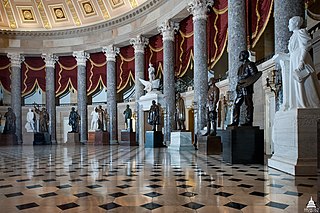
The National Statuary Hall is a chamber in the United States Capitol devoted to sculptures of prominent Americans. The hall, also known as the Old Hall of the House, is a large, two-story, semicircular room with a second story gallery along the curved perimeter. It is located immediately south of the Rotunda. The meeting place of the U.S. House of Representatives for nearly 50 years (1807–1857), after a few years of disuse in 1864 it was repurposed as a statuary hall; this is when the National Statuary Hall Collection was established. By 1933 the collection had outgrown this single room, and a number of statues are placed elsewhere within the Capitol.
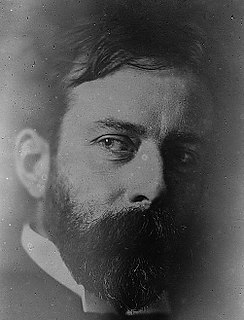
Lorado Zadok Taft was an American sculptor, writer and educator. His 1903 book, The History of American Sculpture, was the first survey of the subject and stood for decades as the standard reference. He has been credited with helping to advance the status of women as sculptors.

Charles Henry Niehaus, was an American sculptor.

The United States Capitol rotunda is the tall central rotunda of the United States Capitol in Washington, D.C. It has been described as the Capitol's "symbolic and physical heart". Built between 1818 and 1824, the rotunda is located below the Capitol dome, which was built between 1857 and 1866.

Hezekiah Augur was an early American sculptor and inventor. He was a self-taught sculptor and, unlike many other 19th-century American sculptors, did not travel to Europe, but spent his entire career in New Haven.

Franklin Bachelder Simmons was a prominent American sculptor of the nineteenth century. Three of his statues are in the National Statuary Hall Collection, three of his busts are in the United States Senate Vice Presidential Bust Collection, and his statue of Ulysses S. Grant is in the United States Capitol Rotunda.
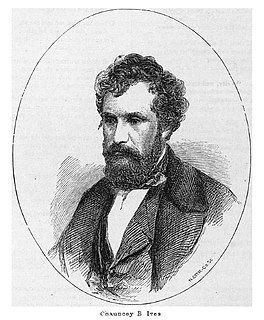
Chauncey Bradley Ives was an American sculptor who worked primarily in the Neo-classic style. His best known works are the marble statues of Jonathan Trumbull and Roger Sherman enshrined in the National Statuary Hall Collection.
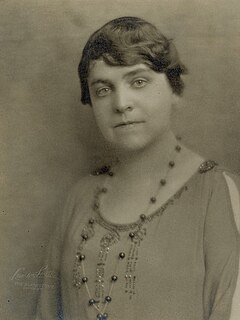
Nellie Verne Walker, was an American sculptor best known for her statue of James Harlan formerly in the National Statuary Hall Collection in the United States Capitol, Washington D.C.
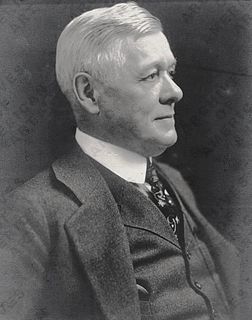
John Massey Rhind was a Scottish-American sculptor. Among Rhind's better known works is the marble statue of Dr. Crawford W. Long located in the National Statuary Hall Collection in Washington D.C. (1926).
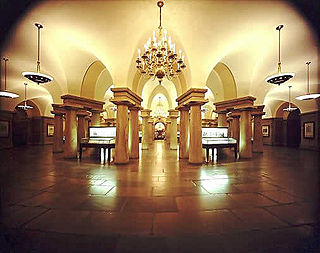
The United States Capitol crypt is the large circular room filled with forty neoclassical Doric columns directly beneath the United States Capitol rotunda. It was built originally to support the rotunda as well as offer an entrance to Washington's Tomb. It currently serves as a museum and a repository for thirteen statues of the National Statuary Hall Collection.
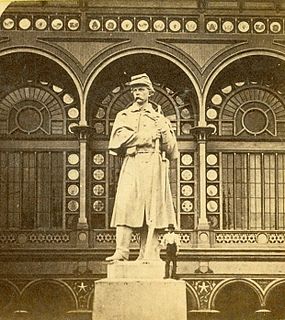
Carl H. Conrads was an American sculptor best known for his work on Civil War monuments and his two works in the National Statuary Hall Collection at the U.S. Capitol in Washington, D.C. He was also known as Charles Conrads.

James Paul Clarke is a marble sculpture depicting the American politician of the same name by Pompeo Coppini, installed in the United States Capitol's National Statuary Hall Collection, in Washington, D.C., as one of two statues gifted by the U.S. state of Arkansas. The 6 foot 10 inch tall statue was placed in the Hall in 1921. The work cost $7,500. and was unveiled in Washington in 1921.

John C. Calhoun is a marble sculpture depicting the American statesman of the same name by Frederick Ruckstull, installed in the United States Capitol's crypt, in Washington, D.C., as part of the National Statuary Hall Collection. The statue was gifted by the U.S. state of South Carolina in 1910.

John M. Clayton is a 1934 marble sculpture depicting the American lawyer and politician of the same name by Bryant Baker, installed in the United States Capitol, in Washington D.C., as part of the National Statuary Hall Collection. It is one of two statues donated by the state of Delaware The statue was accepted in the collection by Robert G. Houston on June 6, 1934.

William King is an 1878 marble sculpture depicting Maine's first governor of the same name by Franklin Simmons, installed in the United States Capitol, in Washington, D.C., as part of the National Statuary Hall Collection. It is one of two statues donated by the state of Maine. The statue was accepted in the collection by Senator Hannibal Hamlin and Senator James G. Blaine on January 22, 1878 who rhapsodized upon the occasion, “He restrained the wrath of the impudent, quickened the zeal of the laggard, dissipated the fears of the doubting and molded his adherents and followers into a compact, cooperative, effective force. .. . He, more than any other man created the State of Maine.”
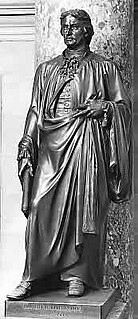
Robert R. Livingston is an 1875 bronze sculpture of Robert R. Livingston, one of the Founding Fathers of the United States, executed by the New York born sculptor Erastus Dow Palmer. The state is installed in the United States Capitol, in Washington, D.C., as part of the National Statuary Hall Collection. It is one of two statues donated by the state of New York.

Peter Muhlenberg, or John Peter Gabriel Muhlenberg, is an 1889 marble sculpture depicting the American clergyman, soldier, and politician of the same name by Blanche Nevin, installed in the United States Capitol's crypt, in Washington, D.C., as part of the National Statuary Hall Collection. It is one of two statues donated by the state of Pennsylvania. The statue was accepted into the collection on February 28, 1889, by Pennsylvania Congressman Daniel Ermentrout.
Francis Harrison Pierpont is a 1910 marble sculpture of Francis Harrison Pierpont by Franklin Simmons installed in the United States Capitol, in Washington, D.C., as part of the National Statuary Hall Collection. It is one of two statues donated by the state of West Virginia. The sculpture was unveiled by the Hon. Thomas Condit Miller, on April 27, 1937.

Roger Williams is an 1872 marble sculpture of Roger Williams by Franklin Simmons, installed in the United States Capitol, in Washington, D.C., as part of the National Statuary Hall Collection. It is one of two statues donated by the state of Rhode Island. The sculpture was unveiled by Senator William Sprague of Rhode Island on January 9, 1872.

Roger Sherman is an 1872 marble sculpture of Roger Sherman by Chauncey Ives, installed in the United States Capitol, in Washington, D.C., as part of the National Statuary Hall Collection. It is one of two statues donated by the state of Connecticut. The sculpture was unveiled by Senator Orris Sanford Ferry of Connecticut on March 8, 1872.



















